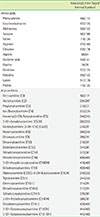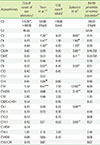Abstract
Background
Methods
Results
Conclusions
Figures and Tables
Table 1
Target/internal standard mass (m/z) of parent ions of amino acids and acylcarnitines

Table 2
Cutoff values for amino acids (µmol/L) extracted from blood spots of newborns

*99.9 percentile of newborns (n=15,000); †4 S.D. above the mean; ‡Reference [4], The authors used PE Sciex micro-LC series 200, PE Sciex micro-Pump, and a Model PE Sciex autosampler in 79,719 Korean newborns; §Reference [6]; ∥Reference [5], The authors used a series 1100 Hewlett Packard HPLC pump, a Model 215 Gilson autosampler and Micromass Quattro LC triple-quadrupole tandem mass spectrometer in more than 160,000 newborns in the USA, especially in Massachusetts, Maine, New Hampshire, Vermont, and Rhode Island; ¶Reference [7], cumulative percentiles for amino acids in neonatal dried blood spots analyzed by tandem mass spectrometry by the participants of the Region 4 Stork collaborative project (as of December 1, 2010); **10 S.D. above the mean; ††7 S.D. above the mean; ‡‡8 S.D. above the mean; §§9 S.D. above the mean; ∥∥6 S.D. above the mean; ¶¶5 S.D. above the mean; ***13 S.D. above the mean; †††11 S.D. above the mean.
Table 3
Cutoff values for acylcarnitines (µmol/L) extracted from blood spots of newborns

0.07For abbreviations of analytes, see Table 1.
*99.9 percentile of newborns (n=15,000); †4 S.D. above the mean; ‡Reference [4], The authors used PE Sciex micro-LC series 200, PE Sciex micro-Pump, and a Model PE Sciex autosampler in 79,719 Korean newborns; §Reference [6]; ∥Reference [5], The authors used 1100 Hewlett Packard HPLC pump, a Model 215 Gilson autosampler, and Micromass Quattro LC triple-quadrupole tandem mass spectrometer in more than 160,000 newborns in the USA, especially in Massachusetts, Maine, New Hampshire, Vermont, and Rhode Island; ¶Reference [7], acylcarnitine cumulative percentiles in neonatal dried blood spots analyzed by tandem mass spectrometry by the participants of the Region 4 Stork collaborative project (as of December 1, 2010); **0.1 percentile of newborns (n=15,000); ††8 S.D. above the mean; ‡‡17 S.D. above the mean; §§11 S.D. above the mean; ∥∥15 S.D. above the mean; ¶¶10 S.D. above the mean; ***6 S.D. above the mean; †††12 S.D. above the mean; ‡‡‡7 S.D. above the mean.
Abbreviation: U, underivatized.
Table 4
Positive cases of neonatal screening tests for inherited metabolic disorders that require confirmatory tests

For abbreviations of analytes, see Table 1.




 PDF
PDF ePub
ePub Citation
Citation Print
Print


 XML Download
XML Download